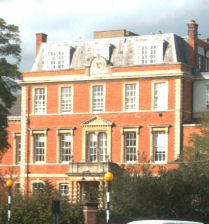Royal Buckinghamshire Hospital
| The Royal Buckinghamshire Hospital | |
|---|---|
| Buckinghamshire Hospitals | |
 | |
 | |
| Geography | |
| Location | Aylesbury,, Buckinghamshire, England, United Kingdom |
| Organisation | |
| Care system | Private |
| Type | Specialist |
| Services | |
| Emergency department | No Accident & Emergency |
| Beds | 22 |
| Speciality | Spinal cord injury, Stroke, Acquired Brain Injury |
| History | |
| Opened | 1832 |
| Links | |
| Website | http://www.royalbucks.co.uk |
| Lists | Hospitals in England |
The Royal Buckinghamshire Hospital (colloquially called the Royal Bucks) is a hospital in Aylesbury, Buckinghamshire, founded in 1832 in response to the cholera epidemic that swept across England at that time. The construction was based on the design of a stately home to help dissociate the assumption at the time that hospitals were a place of death.
History
When it first opened treatment was received by payment only. Admissions were only taken at 11 o'clock every morning (except Sundays) and if the patient had not paid a one guinea a year subscription to the hospital (a kind of insurance to ensure treatment when it was needed) he/she was charged sixpence on admission and was then required to pay a further guinea for further treatment. Patients who were too poor to pay these fees went to the workhouse located on Bierton Hill (now the Tindal Centre).
The current building dating from 1862 replaced an earlier building on the site. The design was influenced by Florence Nightingale who had recently returned from the Crimea and was the first pavilion style civilian hospital to be completed in the UK. She said "It will be the most beautiful hospital in England." Letters and sketches by her about the design are in the Bucks County Council Reference Library.
Florence Nightingale also did a lot of fundraising for the hospital, keeping the admission fees low, ensuring the hospital was able to treat more people.
Originally called the Buckinghamshire Infirmary, it is thought that it became "Royal" after the future Edward VII received treatment there after breaking a limb during a visit to the Rothschilds at Waddesdon Manor.
It was the main hospital for the Aylesbury area all the way through to 1948 when Stoke Mandeville Hospital on the outskirts of town was expanded and took over that role. From that time it became a maternity hospital until the early 1990s when a new maternity wing was opened at Stoke Mandeville.
Renovation
The Royal Bucks, as it had become known, stood empty for a few years, before being partially renovated and turned into a private hospital for the treatment of spinal injuries. It is for this purpose that the hospital is used today.
In 2013 the hospital was purchased by the Affinity Group and currently trades as an independent rehabilitation centre under "Affinity" offering bespoke packages of care for adults.
Treatments
Conditions treated include:
- Spinal cord injuries
- Acquired brain injuries
- Back and neck injuries
- Strokes & neurological conditions
- Orthopaedic conditions
- Post operative mobilisation
- Rheumatic conditions
- Sports injuries.
The hospital provides:
- Intensive rehabilitation programmes and follow-up care
- Outpatient therapies
- Long term care in partnership with its sister facility Kings Lodge Centre for Complex Needs (www.complexneeds.com)
- Acute care in partnership with Bupa Cromwell Hospital and Stoke Mandeville Hospital
- Medico-legal Assessments.
The hospital works with private insurers, the NHS and accepts private referrals.
Facilities
Facilities include: 10-ensuite bedrooms, three rehabilitation gymnasiums equipped with modern technology, an 8.5metre hydrotherapy pool, 2 private and consulting areas and on-site self-contained flats and apartments for relatives and carers. The only publicly available AlterG anti-gravity machine in Bucks is situated here.
The Royal Buckinghamshire Hospital is a provider of Consultant-led rehabilitation and care. The intensive rehabilitation programmes, assisted by the latest technology, are designed to return a patient to maximum possible independence quickly, and to keep time spent in hospital to a minimum. The comprehensive package of post-trauma care for patients and their families provided helps to accelerate recovery.
